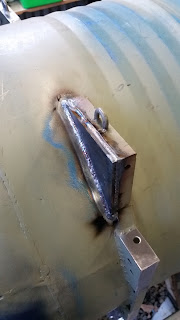This is the last of the Hoisting Points updates.
I spent the last few hours putting the last two hoisting points together, then grinding all the welds flat and rounding edges on everything before giving it a coat of paint. Tomorrow I'll be finishing of the rear dome and putting the motor and elevator system back on.
I spent the last few hours putting the last two hoisting points together, then grinding all the welds flat and rounding edges on everything before giving it a coat of paint. Tomorrow I'll be finishing of the rear dome and putting the motor and elevator system back on.
This weekend I'll make a start on, and hopefully finish, the mounts for the batteries. After that I've got to make, and mount the throttle; mount the elevator and diving plane controls, and finish of the ballast release mechanism. Once these are done I can paint the interior (only the front and back for now) then I can start work on the conning tower; hatch, windows and electronics, etc.



















































